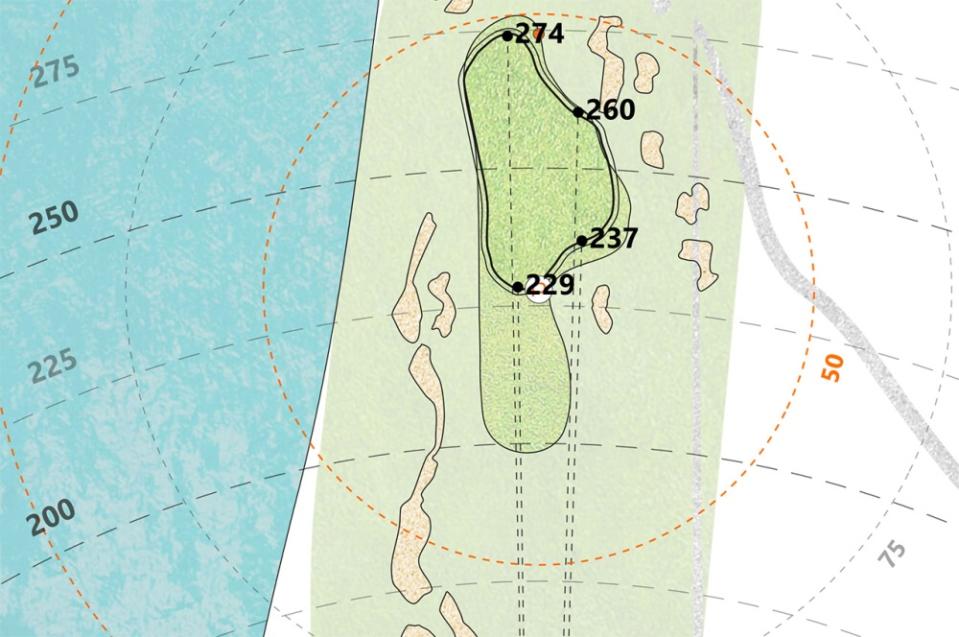The Straits Course twists and turns to test tour pros. Match play in the Ryder Cup should only make it better.

The caddie pointed at a line left of the fairway bunker on No. 4 of Whistling Straits’ Straits Course, urging me to swing away at a target that I simply couldn’t see or even properly imagine. The only comfortable grassy stretch appears to sit farther to the right than the caddie indicated, perhaps offering a bit of a bailout on this tee shot?
Nope. Should have listened to the caddie. With a freshening wind at my back, I went too far right— the thin stretch of fairway proved to be a mirage. The ball found the edge of a bunker, and the ensuing double bogey proved I had no idea how to play that hole.
Just as Pete Dye intended in 1998 when he opened Whistling Straits, site of this year’s Ryder Cup.
A master of disguise. A Tour pro’s nightmare. An artist. A genius. The most creative guy in the room with perhaps the most dirt under his fingernails after long days playing in a field. All these qualities have been ascribed to Dye, who passed away aged 94 in January of 2020 after having built more than 100 courses around the world. And each of those descriptions and more came into play when Dye built the Straits Course tight to Wisconsin’s shoreline of Lake Michigan.
One other word that comes to mind in describing Dye’s efforts at the Straits: counteroffensive.
By the 1990s, Dye had grown tired of seeing Tour professionals gain length off the tee. The best players in the world were just blasting balls past hazards that no longer lived up to that moniker—it’s a trend that has continued, with prodigious Tour length too often dominating strategy. Always interested in getting into the heads of the pros and thumbing his nose at their power, Dye constructed a layout of twists and turns, humps and hollows, sand and more sand. If pros could hit just about any target within sight, why not simply hide those targets to mess with the best?
The result is a thrilling procession of landing areas set on diagonal lines tucked behind mounds or bunkers to create semi-blind and uncomfortable tee shots. And those landing areas are frequently pinched just as they turn to the side, putting even greater demands on a player with a driver in his hands. There are no easy decisions to lay back, as overly cautious tee shots often leave long, obscured second shots from bad angles.
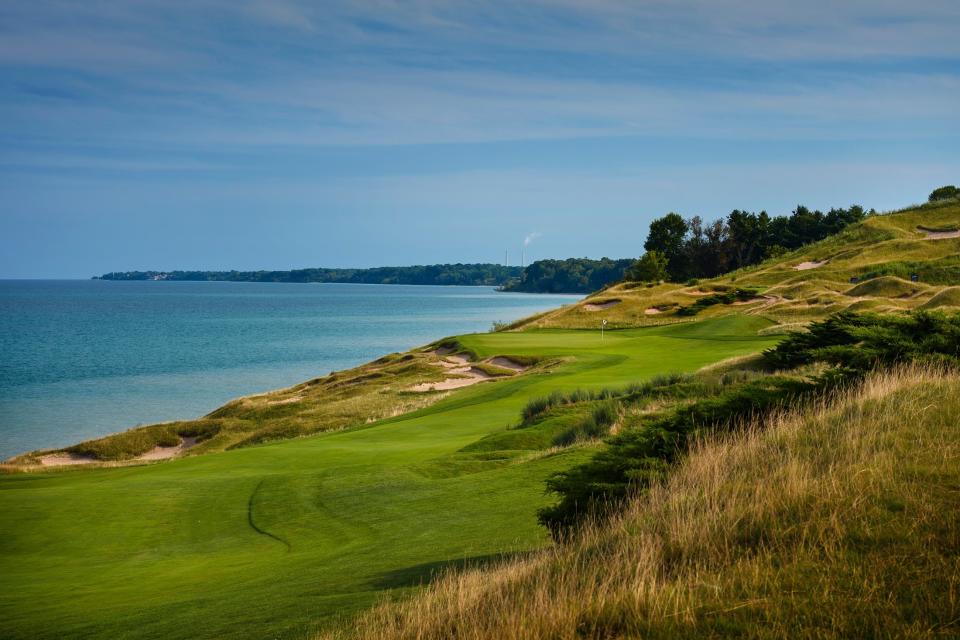
Whistling Straits, No. 4
The aforementioned No. 4 is a perfect example, with the fairway tumbling hard left out of view toward the shore of the lake at exactly the distance—300-320 yards off the back tee—that most modern Tour professionals would want to land a tee shot. Such deception happens time and again on the Straits—there’s the fairway grass you can see, and way over there is a better target behind a bunker lip or mound of waving fescue.
This version of Dye’s counteroffensive messes with a player’s mind, and all the demands to either play safe or take on tremendous risk can be exhausting.
“The Straits course is really one of his masterpieces,” Mike O’Reilly, the golf operations manager at Whistling Straits and its sister club, Blackwolf Run, said of Dye. “I think he did an amazing job with the visual intimidation on any particular shot, then you get out to the space and say, it didn’t really look like this from back at the tee box. Just some of those mind tricks that he plays—it looks very difficult, very visually intimidating.”
A huge part of that intimidation comes from the bunkers, which appear to be everywhere. Sand short, sand long, even sand way out of play that shouldn’t receive any players’ footprints during this Ryder Cup. There are nearly 1,000 spots on the course that might be considered bunkers.
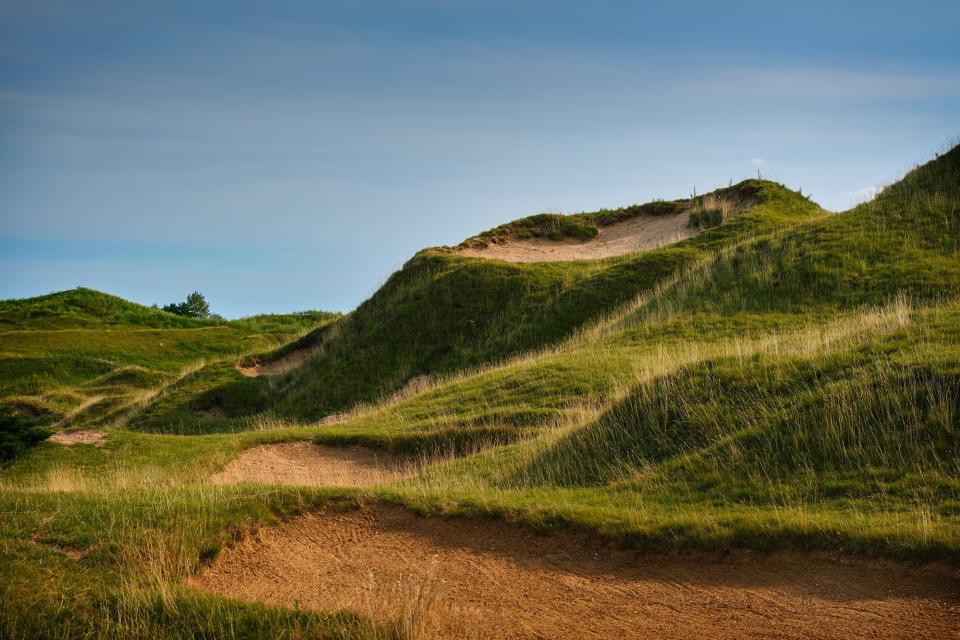
Some of the many bunkers at Whistling Straits.
The most notorious of those bunkers at the Straits sits alongside No. 18 and was the final resting spot of Dustin Johnson’s ambitions to win the 2010 PGA Championship, one of three such major championships to have been played at the course. Johnson found a sandy patch to the right of 18 fairway. Believing it to be just a bare spot in the turf, he ground his club before attempting his shot. Problem is, a local rule that week declared all sand areas on the course were bunkers, and Johnson was tagged with two penalty shots. That knocked him out of a playoff in which Martin Kaymer beat Bubba Watson.
The DJ bunker, as it’s become known, was covered by a corporate hospitality tent for the 2015 PGA Championship and very well may be again for this Ryder Cup. Still, O’Reilly said the PGA of America plans to play all such sandy areas as bunkers for the Ryder Cup, and players cannot ground their clubs within them.
All the sand on display is fitting for a course that required some 13,000 truckloads of imported material to build. The Straits and the adjacent Irish Course were constructed on a flat site that once housed a military artillery range. Climb to the top of the manmade hill behind No. 13 green and you can see flat farmland stretching to the horizon along the shore. That was the blank canvas on which Dye created some of the most striking golf holes in North America, all from scratch.
The Straits is slated to play to 7,390 yards for the Ryder Cup with a par of 71. The layout normally plays as a par 72, but it is expected the tee will be moved up on No. 11, turning what is normally a par 5 into a par 4.
The stars of the show are the par 3s, each of the four perched directly above Lake Michigan. They range in length from 143 to 223 yards off the back tees and are positioned to take the most direct buffeting of wind off the lake. In combination, they offer one of the most stunning quartets of par 3s found anywhere, each a tribute to Dye’s imagination.
It was that level of creativity that led to the Straits ranking No. 8 on Golfweek’s Best Modern Courses list for layouts opened in or after 1960 in the United States. It also ranks as the top public-access course in Wisconsin and is the highest-ranked of Dye’s 18 courses that make the Modern Courses list. The Straits also caps a strong trifecta of Dye courses to host top events this year— the Players Championship is played at his TPC Sawgrass Stadium Course each year, and the PGA Championship was at his Kiawah Island Golf Resort Ocean Course in May.
Dye already had built Sawgrass’s Stadium Course (1981) and Kiawah’s Ocean Course (1991) before tackling Whistling Straits. He also had built two other tracks at Destination Kohler, the new resort helmed by plumbing magnate Herb Kohler in the factory town named for his family. The River Course and Meadow Valleys at Blackwolf Run, some nine miles south and inland of Whistling Straits and nearer the resort’s American Club, had kicked off Kohler’s relationship with Dye. When Kohler wanted to expand his resort’s golf amenities, Dye again got the nod to build the two courses at Whistling Straits.
Even before the first shovel struck ground at Whistling Straits, Kohler had big plans to host major events. And from the outset of their relationship, Kohler relished Dye’s determination to challenge the best players.
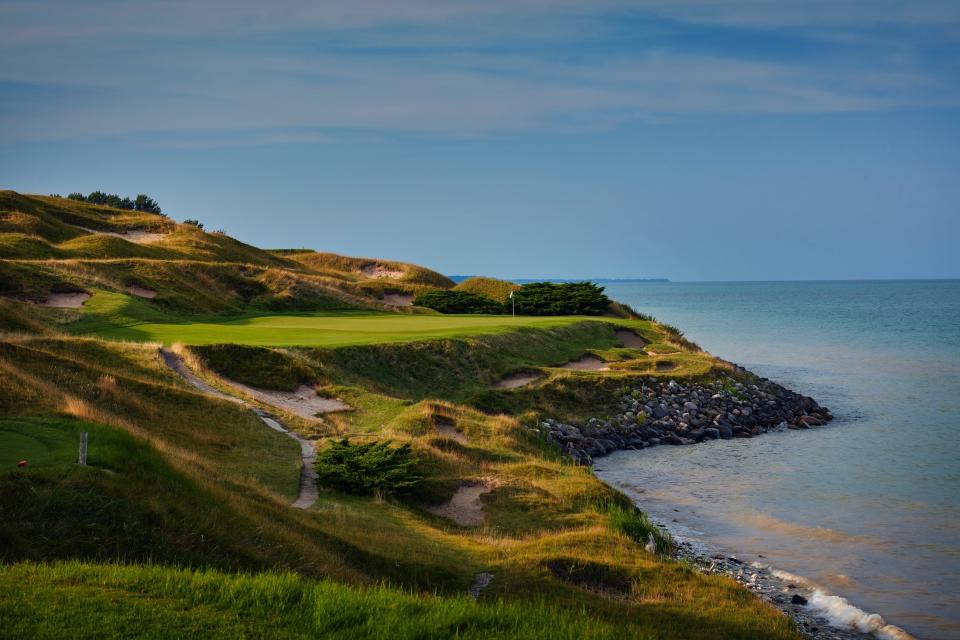
Whistling Straits, No. 7
“This one particular chap, he was an odd duck, but he had two courses in particular that were of interest,” Kohler told Golfweek a few years back. “One that had just been open to the public, it was the TPC at Sawgrass, the home course for the PGA Tour. And at least 20 different pros who had a chance to play it were extraordinarily upset, and they were making their feelings known to the local press. … It sort of fascinated me. What I liked about it was, he had this desire to get into the psyche of a pro and really befuddle him.
“This fellow, Pete Dye, took them right to the edge of embarrassment, and they didn’t like being embarrassed, but I enjoyed it.”
So Dye was hired to sculpt all those truckloads of sand into one of the most difficult and perplexing golf courses in the world, building for Kohler an American version of a wild Irish links course. Having a beautiful waterfront location but no great natural terrain with which to work, Dye set about the task with ample imagination and enormous financial support. The results are soaring dunes that drop from the western side of the layout toward the bluff and the lake, providing ample viewing spots for spectators while challenging the pros to pick the proper lines.
Finding the fairways is a must, even for these long-hitting superstars slated to appear in the Ryder Cup. This isn’t a normal Tour course where bomb-and-gouge strategies typically reward whichever player is closest to the green, rough be damned. There are just too many fescue-covered, uneven, sandy and generally bad-tempered lies off the fairways at the Straits to allow for easy recoveries.
“Players ask me, ‘Mike, what advice do you have for me playing the Straits Course?’ And I just say, ‘Hit it in the fairway,’ ” said O’Reilly, who began his career as a caddie at Blackwolf Run before Whistling Straits even opened. “That’s the most important shot, just keeping it in play off the tee. If you keep it in play off the tee and don’t get too overwhelmed with the visuals, you’re going to do just fine. …
“The severity of the bunkers and the dunes and the mounding, you’re going to find yourself in some goofy lies. And I don’t care how good you are, from there it’s going to be difficult to get it up around the green.”
The reward for keeping it in play could be plenty of birdie putts on relatively flattish greens for a top-tier professional event. It wouldn’t be right to describe the putting surfaces as easy, especially under the searing pressure of a Ryder Cup. But these greens don’t resemble those at Augusta National, for example, and its arduous putting challenges. Players can make their fair share of putts on the Straits, so in that way Dye first taketh away from the tees, then he giveth back on the greens.
Also able to give and take away is U.S. captain Steve Stricker, a Wisconsin native and 12-time winner on the PGA Tour. He and the PGA of America will oversee the course setup each day, and he has plenty of options to move tees and flagsticks to benefit his long-hitting American squad.
“Whistling Straits, one of the best things about it for hosting a large event and certainly a Ryder Cup is the flexibility,” O’Reilly said. “There are a lot of things you can do with the golf course. There are multiple tee boxes on every hole that make the opportunity for Captain Stricker to look at the hole and say, you know the wind direction will be this today, let’s do this.”
Prime examples of holes with strategic options include Nos. 13 and 14, both par 4s arriving at a key stretch of the back nine when matches often tilt in one team’s favor. Both holes appear too long on the scorecard to be reasonably reached off the tee—No. 13 is 404 yards, and 14 measures 401 on the card. But depending on wind direction and a player’s bravado, both greens might be within range of a driver.
No. 13 fairway slopes left to right and downhill for the last 125 yards or so, allowing a player to possibly feed a downwind tee shot onto the green. Stricker could play with the tee location to make it even more possible.
Then 14 takes the term dogleg to great extremes, as the fairway abruptly curves 300 yards off the tee. A series of bunkers guards the leftward and direct line to the green, requiring a carry of about 315 yards to fly the sand and possibly scoot a ball onto the green—not out of the realm of possibility for bombers such as Dustin Johnson, Bryson DeChambeau or Rory McIlroy. But a miss will find trouble, trouble or more trouble. Stricker has the option to make it even more enticing by moving the tee markers up just a few steps.
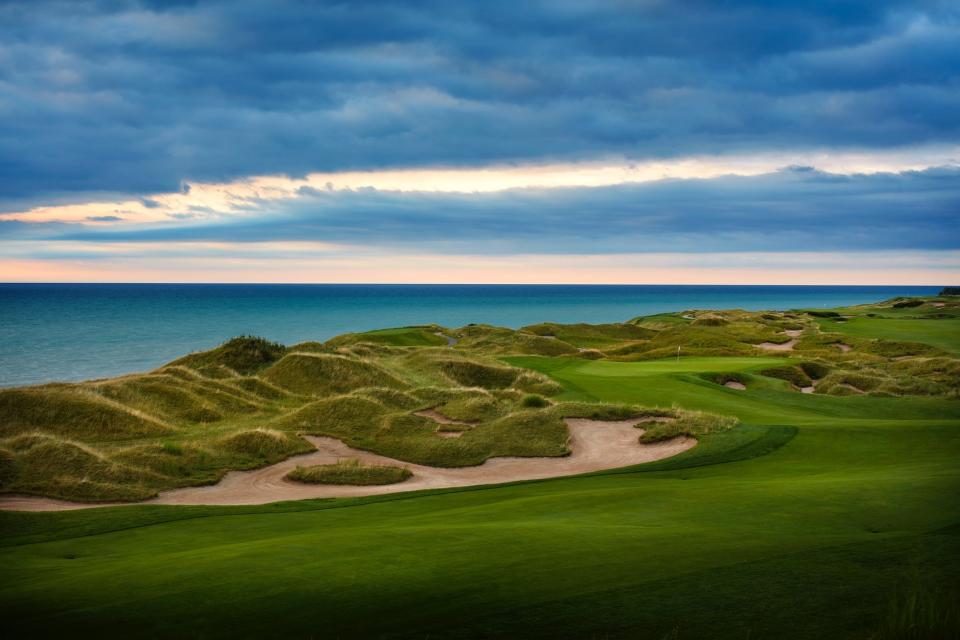
Whistling Straits, No. 14
“It’s a true risk-reward hole, a really good hole for a Ryder Cup,” O’Reilly said. “If (the players) keep it far enough left off the tee and do carry the bunkers, they can roll right onto the green and have a putt at eagle. If they miss just a little bit right of that, they’re going to pay a penalty.”
From there it’s a long par 4 at No. 15, a reachable par 5 at No. 16 if the wind cooperates, then one of the most scenic holes in the game. No. 17 is a 223-yard par 3 perched directly above the lake, with any tee shot left of the green likely cascading down the bluff into all sorts of double and triple bogeys. Keeping in true Straits fashion, the safer right side of the green is obscured by a mound of fescue and a pot bunker.
“It makes the entire green look smaller,” O’Reilly said. “You can’t see a good portion of the right side of the green, so again a little mind trick.”
It doesn’t get any easier from there. No. 18 is a somewhat bizarrely shaped, dogleg-left, 515-yard par 4 with a minefield of bunkers protecting the direct line off the tee. From the fairway, a creek fronts the green inside an amphitheater setting that should be electric during the Ryder Cup.
O’Reilly said many players will opt to hit a 3-wood up the right side to a relatively safe patch of fairway—that is almost always the right choice during stroke-play events, but it leaves a much longer second shot. However, this is the Ryder Cup and this is match play, so a long hitter might be more tempted to try the heroic, semi-blind, 315-yard carry over the sand to set up a short-iron approach to a demanding green that has four distinct lobes. It’s perfect as a match-play closer—an incredibly difficult, do-or-die finishing hole layered with risk and possible reward.
Just as Dye intended.
List
Check the yardage book: Whistling Straits for the Ryder Cup
